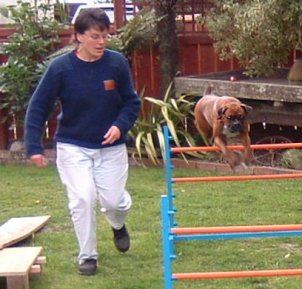Pet articles and information
| Agility, dog agility, dogs, agility training, commands, Border Collies, sport, obstacles, obstacle course, pole, poles, agility club, trainer |
Addicted to agility
Author: Eleanor Hunt
Dogs - and their owners - around the globe are becoming addicted to agility - and it's no wonder. This fast-paced, competitive canine sport has dogs jumping through hoops.
Agility is an obstacle course for dogs, who have to vault hurdles, jump through hoops, run through tunnels, dash over seesaws, weave through poles and negotiate other obstacles, whilst being timed. Faults include knocking down the pole of a hurdle and missing the 'contact point' - a colored part near the end of a seesaw or other obstacle.
 Whilst Border Collies dominate the sport, most dogs can compete - Golden Retrievers, Belgian Shepherds, German Shorthaired Pointers, Papillons, Schnauzers, Miniature Poodles, Australian Kelpies, Shetland Sheepdogs and Jack Russell Terriers are among the breeds that have had success in agility. Breeds such as Boxers can also compete, but are prone to overheating because of their short noses - if you own one of these dogs and want to try agility, make sure your dog is given plenty of water often. Dogs with short legs (excluding Welsh Corgis, which have proven to be quite successful at this sport) or long backs aren't suitable for agility.
Whilst Border Collies dominate the sport, most dogs can compete - Golden Retrievers, Belgian Shepherds, German Shorthaired Pointers, Papillons, Schnauzers, Miniature Poodles, Australian Kelpies, Shetland Sheepdogs and Jack Russell Terriers are among the breeds that have had success in agility. Breeds such as Boxers can also compete, but are prone to overheating because of their short noses - if you own one of these dogs and want to try agility, make sure your dog is given plenty of water often. Dogs with short legs (excluding Welsh Corgis, which have proven to be quite successful at this sport) or long backs aren't suitable for agility.
Why compete in agility? There are several reasons - most dog owners are just looking for a fun hobby that their pets can share with them. Agility is also a great method of strengthening the bond between you and your dog. Other reasons for competing in agility are - it's fun, it's good exercise for dogs and people, it provides mental stimulation for dogs and it build physical and mental confidence in shy and retiring dogs. It also improves the general control you have over your dog and it's a good way to meet other people with similar interests.
However, you can't just grab your dog and head for the obstacle course. Your dog needs to know lots of new commands, including 'over', 'through', 'left' and 'right'. These are best taught by someone who has experience with agility, so contact your national agility club for details of a trainer in your area. Also, a trainer will be able to provide equipment to practice on - which means that you don't have to buy or make it yourself. Look for a trainer that uses reward-based training methods and avoids choke chains, which can catch on the obstacles and cause your dog serious injury.
Bear in mind that dogs have to be over the age of 18 months before they can start training in agility - this is to prevent your dog damaging his joints. You shouldn't compete in agility if your dog has arthritis or hip dysplasia. Although the obstacles vary, the more often-seen ones are:
- Weave poles. These are between six to twelve poles that are put in a row. The dog has to weave in between each pole as quickly as he can. Most dogs love this obstacle and become amazingly fast.'
- Seesaws, otherwise known as teeter-totters. These are just like the ones that children play with. Both ends of the seesaw are painted a different color to the plank - these colored parts are known as 'contact points'. Not touching the contact point is a fault.
- Hurdles. The hurdles in an agility competition are like the ones that horses jump over. Two hurdles are often set out next to each other, so the handler has to direct the dog which one to jump over.
- Tyres. These are suspended in windows in rectangular frames - the frames are sometimes painted to look like wells. The dog has to jump through the tyre.
- Tunnels. There are several variations of this obstacle - some tunnels have openings that are made out of fabric, others have two entrances.
- A-Frames. These are named because of their shape, which is exactly like a capital 'A'. The dog has to run up the side of the A-frame, and come down the other side. This obstacle has contact points.
- Tables. The dog has to jump onto a table, lie down and pause for around five seconds before moving onto the rest of the course. Jumping off before the judge's signal is a fault.
Agility... it's the sport that has dogs howling for more!
Content by courtesy of: Eleanor Hunt
Home | Dogs | Cats | Birds | Fish and aquariums | Ferret | Small pet | Free classified ads | Photos | Videos | Articles |
